Summary of June itinerary in Japan ( Osaka, Kyoto )
I traveled to Osaka, Kyoto, and Aichi Prefectures from Wednesday, June 8 to Friday, June 10. On this trip, I was able to eat a lot of seasonal seafood and local cuisine such as sea bass and sweetfish, and visit wonderful sightseeing spots such as world heritage sites, national treasures, and national important cultural properties. I strongly recommend that you travel in June, especially in Osaka, Kyoto, and Aichi Prefectures, which are not suitable for travel in July and August due to the extremely hot weather. Here is a summary of our trip and some notes.
Table of contents
1.”100 best of local dishes” and “Local dishes loved by the nation” by this itinerary in Japan
2. Seasonal “PRIDE FISH” by this itinerary in Japan
3. Travel precautions for itinerary in Japan
Again, each time, this itinerary was also created with the objective of “eating all the seasonal seafood and local cuisine”. Food is the first priority, and sightseeing spots are second. Nevertheless, I aimed to visit as many sightseeing spots as possible, including World Heritage sites, national treasures, and national important cultural properties.
1.”100 best of local dishes” and “Local dishes loved by the nation” by this itinerary in Japan
Osaka prefecture : Hako-zushi and Okonomiyaki
I was able to eat Hakozushi (mackerel sushi) from “100 best of local dishes” and Okonomiyaki from “Local dishes loved by the nation” in Osaka.
Hako-zushi is a square wooden frame filled with sushi rice and topped with ingredients, which are then pressed down by hand to adhere to the rice and ingredients. It is also called Oshi-zushi. Originally, Oshi-zushi called Battera was popular in Osaka, using mackerel and other popular fish as ingredients. Later, it developed into the more upscale “hako zushi” using not only mackerel but also sea bream, shrimp, conger eel, and other ingredients.
Therefore, the mackerel sushi I had this time is the original Hako-zushi. The mackerel sushi at Abaraya in Namba, which is made without vinegar and finished with salt, was very tasty and unlike anything I had ever tasted before.
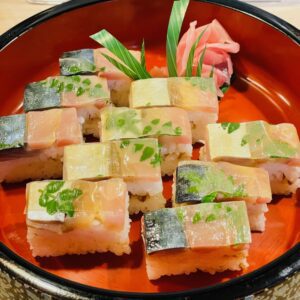
Incidentally, the word “Battera” comes from the Portuguese word “bateira,” which means “small boat”. The name “Battera” was derived from a sushi restaurant in Osaka that initially served gizzard shad on sushi rice, which looked like a small boat. Even when the fish on the boat was changed from gizzard shad to mackerel, it was still called “Battera”. However, it is unclear why Portuguese was used for sushi.
All people know about okonomiyaki, so there is nothing special to explain. However, many okonomiyaki restaurants in Osaka use a lot of yams in the dough, so I think the main difference is that the texture is softer than most okonomiyaki outside of Osaka. The “Abeton” in Tennoji that I ate was also a delicious okonomiyaki with a very soft texture. I hope that other okonomiyaki restaurants outside of Osaka will also use more yams and offer delicious okonomiyaki with a softer texture.
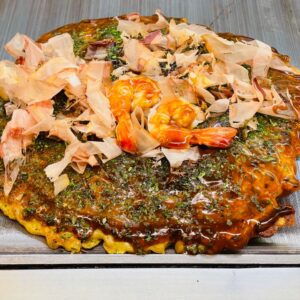
Kyoto Prefecture : Kamo eggplant dengaku
In Kyoto, I was able to eat Kamo eggplant from “100 best of local dishes“. In fact I ate it as “Kamo eggplant and beef grilled in soy sauce” instead of “Kamo eggplant dengaku”. This is because there was no dengaku of Kamo eggplant at “Seppourai” in the Kyoto Station Building where we dined. It was my first experience to eat Kamo eggplant with beef, but it was a very tasty dish.
 賀茂茄子-e1655266529246-300x300.jpg)
Kamo eggplant has been selected as both a “Traditional Kyoto Vegetable” and a “Kyoto Brand Product”. There are only 13 vegetables that have been selected for both categories.
No dish from Kyoto Prefecture has been selected for the “Local dishes loved by the nation”. However, many dishes have been selected for “Our Regional Cuisine,” and this time I was able to try Manganji Togarashi and Hamo (pike conger eel). In the “Our Local Cuisine”, the dish is listed as “Boilled Manganji Togarashi and dried young sardines” and “Hamo no yakimono” (grilled conger pike), but I had it as “grilled Manganji pepper” and “Hamo no yubiki” (parboiled conger pike).
 万願寺-e1655266807512-300x300.jpg)
 鱧湯引き-e1655267237505-300x300.jpg)
Aichi Prefecture : None
Since I went to Aichi Prefecture only to have dinner with my college friends, I could not eat either “Hitsu-mabushi (Eel in a tub)” or “Miso-nikomi Udon (Noodles in miso broth)” in the “100 best of local dishes”. In addition, there is no “Local dishes loved by the nation” from Aichi Prefecture.
However, this time I was able to eat Kishimen, which was selected as “Our Regional Cuisine”. Whenever I visit Nagoya, I always eat Kishimen at “Sumiyoshi” on the station platform. Kishimen is my favorite dish at Sumiyoshi.
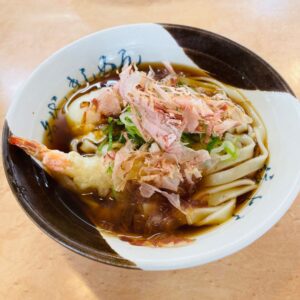
The “100 best of local dishes”, “Local dishes loved by the nation” and “Our Regional Cuisine” are selected by the Ministry of Agriculture, Forestry and Fisheries.
2. Seasonal “PRIDE FISH” by this itinerary in Japan
Osaka: Osaka sea bass (season: July to September), Naniwa no Madako (octopus) (season: June to October), and Osaka conger eel (season: April to June)
In Osaka, three types of seafood were available from PRIDE FISH. Sea bass is in season from July to September, but June, when I visited, was also a good enough time to enjoy it. I ate sea bass grilled in Osaka and as carpaccio in Kyoto. Both grilled and carpaccio sea bass were very tasty.
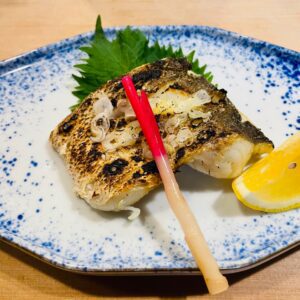
 鱸のカルパッチョ-e1655264750734-300x300.jpg)
I ate octopus as sashimi in Osaka. Because Osaka Bay is rich in food such as shrimp and crabs, and the tides are calm, octopus grow in the bay, making them flavorful and tender. The octopus sashimi I had this time was also very tasty.
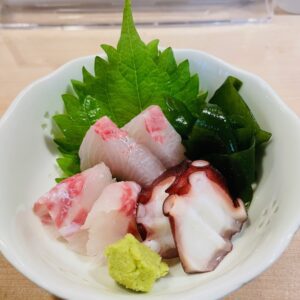
I had the broiled (kabayaki) conger eel in Osaka. The conger eel was a little small, but it was tasty enough.

Kyoto Prefecture: None
I did not have a chance to eat “PRIDE FISH” in Kyoto Prefecture.
Aichi Prefecture: None
There was no opportunity to eat “PRIDE FISH” in Aichi Prefecture either.
PRIDE FISH” is selected by Japan Fisheries Co-operative.
3. Travel precautions (local trains) for itinerary in Japan
I write the same thing every time, but I repeat it because it is important. Once again, the rules of the trip are that it is an environmentally friendly trip, using only public transportation, including bicycle rentals.
This is also a reconfirmation, but travel by public transportation emits far less CO2 than travel by car. For example, according to data from the Ministry of Land, Infrastructure, Transport and Tourism, CO2 emissions per person traveling 1km by air are 98g (75% of the amount for cars), 57g (44% of the amount for buses), and 17g (13% of the amount for trains), compared to 130g for cars.
Again, it was difficult to understand how to get on and off the one-man train (conductorless train). From Sonobe Station to Hiyoshi Station on the JR San-in Honsen Line was a one-man train. Normally, only the front door of the first car opens, but because the train was crowded, an announcement was made that “all doors will open”. However, when the train arrived at the station, the doors did not open. I wondered why, and then I found out that the doors other than the first door of the first car had to be opened by pressing the open/close button. I was surprised because I had expected that all doors would open automatically when the announcement said “all doors will open”.
After all, boarding a one-man train is difficult even for Japanese. And considering that the information is given only in Japanese, foreigners who do not understand Japanese would not understand how to get on and off the train at all. There were posters on the train about how to get on and off the train, but they were only in Japanese. Train operators and tourist associations should be responsible for providing information in foreign languages.
Again, we will describe how to get on and off a one-man train.
When getting on and off a one-man train, you must press a button to open the door. When boarding, you take a numbered ticket, and when getting off, you put the ticket and money in the fare box.
For one-man trains, it is safe to always ride in the first car. When traveling in rural areas of Japan, you should definitely remember the rules for getting on and off the train. However, whether to ride from the front or rear door of the first car depends on the train operator.
Please see the detailed notes on each of the travel days.
4. Travel in a light style
Again, this is a recurring theme, but on this trip, I sent my own clothes and power cord to the hotel in advance and enjoyed “luggage-free travel” every day. After all, it is so much easier to travel light (no luggage) like going for a walk. Being able to act immediately after arrival by train or plane is important for effective use of time. On the last day of my trip, I sent the clothes I wore during the trip to a laundry service and did not have to do laundry. I hope everyone will experience the comfort of “luggage-free travel”.
5. June 8 (Wednesday) Day 1
First of all, I went to Tsutenkaku Tower.
As you know, Tsutenkaku Tower is the symbol tower of Osaka. The current Tsutenkaku Tower is the second generation and was completed in 1956. The height including the lightning rod is 108m. It is designated as a national registered tangible cultural property.
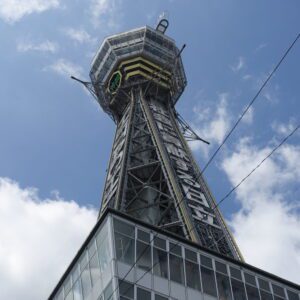
The area around Tsutenkaku Tower is a downtown area, Shinsekai (the New World) that retains the atmosphere of the Showa period. It is a pity that the puffer fish dish “Zuboraya”, which was a symbol of Shinsekai, closed in September 2020 and the large puffer fish lanterns were removed.
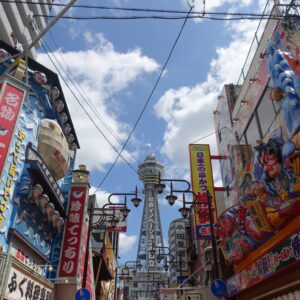
I went to Yasui Shrine, which is a little over 5 minutes on foot from Tsutenkaku Tower. Yasui Shrine is the place where Nobushige Sanada (Yukimura Sanada) died during the “summer campaign of the siege of Osaka” in 1615. In the precincts of Yasui Shrine, there is also a monument to the war dead of Yukimura Sanada and a statue of Yukimura Sanada.


I went to Shoman-in, which is a little over 5 minutes on foot from Yasui Shrine. It is also called Aizen-do because its principal image is Ragaraja (esoteric school deity of love). According to the temple, it starts at the Shiyaku-in in Shitennoji, which was opened by Prince Shotoku. The year of foundation is said to be 593.
The Kondo was destroyed by fire in 1615 by “summer campaign of the siege of Osaka”, but in 1618 the Kondo was rebuilt by Hidetada Tokugawa, the second shogun of the Edo Shogunate. The main hall is designated as a tangible cultural property of Osaka Prefecture.
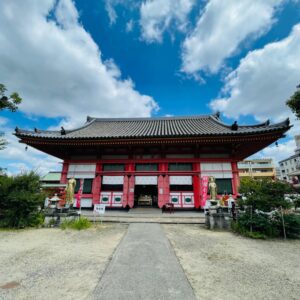
Tahoto is the oldest wooden structure in Osaka city. The Tahoto was rebuilt in 1597 by Hideyoshi Toyotomi. The Tahoto is designated as a national important cultural property. It was a very nicely shaped Tahoto and I was fascinated by it for a while.
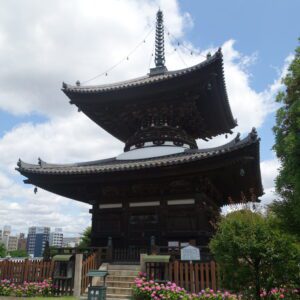
The Aizen Festival, which is a festival of Shoman-in, is one of the Three Great Summer Festivals of Osaka and is an intangible folk cultural property of Osaka City. 2022 will be held for two days, June 30th and July 1st. For the two days of the Aizen Festival, there will be a Gokaicho (special opening of the Ragaraja of the Kondo and the Dainichi Daisho Kongoson of the Tahoto.
I went to Shitennoji Temple, which is less than 10 minutes on foot from Shoman-in. Shitennoji is the head temple of the Washu. It was founded in 593. It is a temple built by Prince Shotoku, like Horyuji Temple in Nara Prefecture. Shitennoji Temple, along with Asukadera Temple in Nara Prefecture, is said to be the oldest full-scale Buddhist temple in Japan. Horyuji Temple was founded in 607.
The arrangement of the cathedrals of Shitennoji is called “Shitennoji style layout of Buddhist temple”. From south to north, the central gate, five-storied pagoda, kondo, and auditorium are lined up in a row. The corridor surrounds the buildings and is considered to be the oldest architectural style.
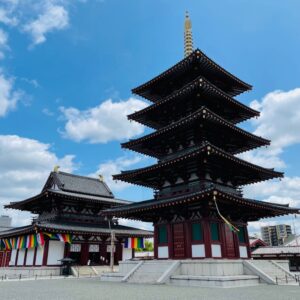
Shitennoji Torii, Ganzandaishido, the stone stage, and Rokujiraisando are national important cultural properties. The stone stage is one of the “Japan’s Three Stages”. The other stages of “Japan’s Three Stages” are Sumiyoshi Taisha and Itsukushima Shrine. I think the stone stage of Shitennoji is the most magnificent of the “Japan’s Three Stages”.
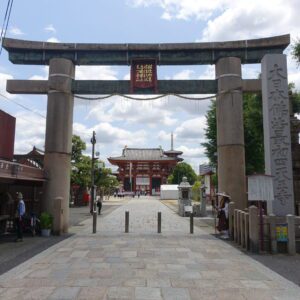
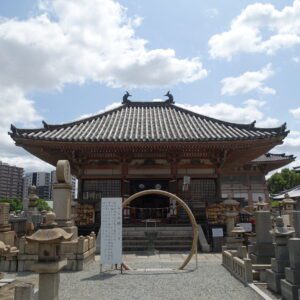

The statue of Nio in the middle gate (Niomon) is made by Horin Matsuhisa and Sorin. The statue of Nio is the second largest statue of Nio at the Nandaimon Gate of Todaiji Temple in Nara Prefecture.
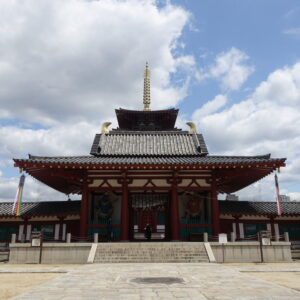
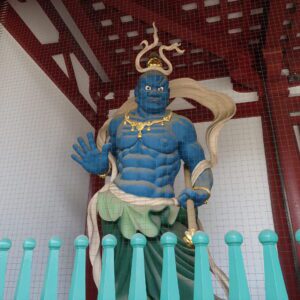
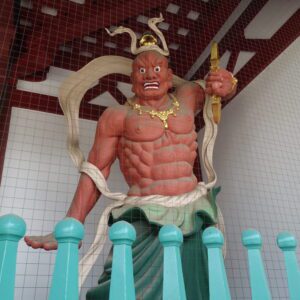
I went to Sumiyoshi Taisha Shrine after lunch.
I didn’t know that there was a tram in Osaka as well. The Hankai Denki Uemachi Line was originally opened as a horse-drawn carriage railroad in 1900 for the purpose of transporting worshipers to Shitennoji Temple and Sumiyoshi Taisha Shrine. It is natural that I felt that the access from Shitennoji to Sumiyoshi Taisha was convenient.
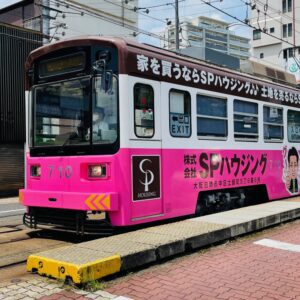
Sumiyoshi Taisha is the head office of Sumiyoshi Shrines nationwide. According to Sumiyoshi Taisha, it was founded in 211. The four main shrines of Sumiyoshi Taisha (first main shrine, second main shrine, third main shrine, fourth main shrine) are national treasures. They were built in 1810. The main shrines have a unique style called “Sumiyoshi-zukuri” and is positioned as the oldest style of the main shrine dating back to the Asuka period (592-710).
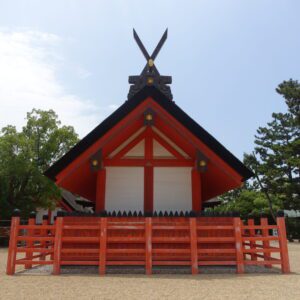
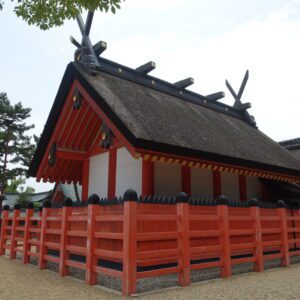
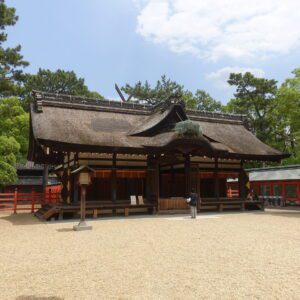

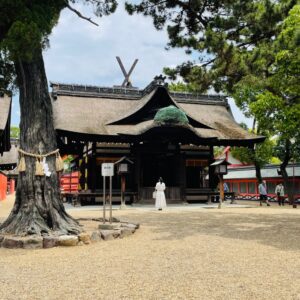
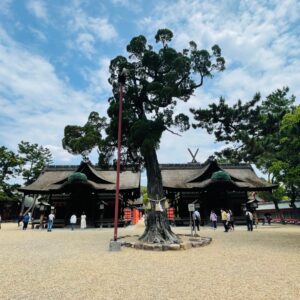
The South Gate and the Gakusho (East and West Gakusho) on both sides are national important cultural properties. Hideyori Toyotomi rebuilt them in 1607.
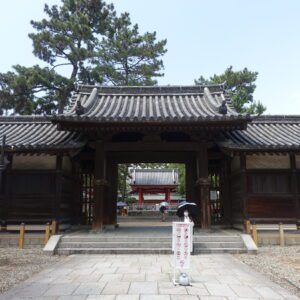
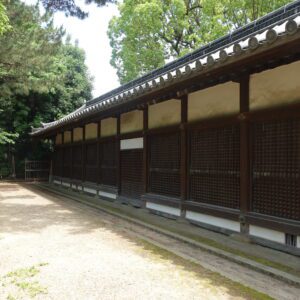
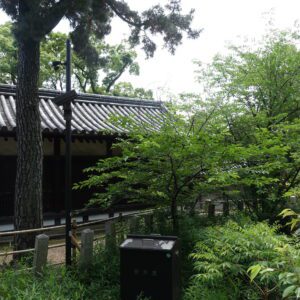
The Ishibutai (stone stage), which was rebuilt by Hideyori Toyotomi, is located near the South Gate and the Tozai Gakusho. Like the stone stage at Shitennoji Temple, it is one of the “Japan’s Three Stages”. However, it is about half the size of the Ishibutai at Shitennoji Temple. The Ishibutai of Sumiyoshi Taisha Shrine is also a national important cultural property.
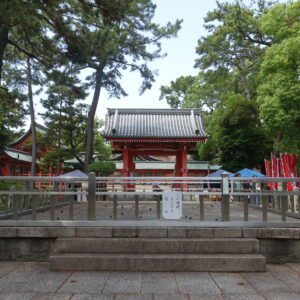
Sorihashi, also called Taiko-bashi, is the symbolic bridge of Sumiyoshi Taisha. The bridge is 4.4 meters high and is not easy to cross.

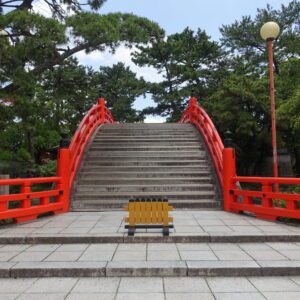
In front of the Koujumon gate is a “Kaku-torii” (square torii). The name “Kaku-torii” comes from its square pillars, and is called “Sumiyoshi-torii” because of its unique form.
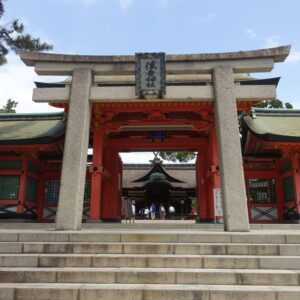
Even though it was a weekday, there were so many people visiting Sumiyoshi Taisha. I could clearly see that Sumiyoshi Taisha Shrine is supported by many deeply religious people.
I headed to Kanshinji Temple after Sumiyoshi Taisha.
I rented a bicycle at the Kawachinagano City Tourist Information Center and headed to Kanshinji Temple by bicycle.
It is said that Kanshinji was founded by En no Gyōja in 701. After that, it is said that Kukai prayed for the coming of a deity, the Great Dipper in 808.
The Kondo Hall of Kanshinji Temple was built during the Shohei Era (1346 – 1370) and is a national treasure. It is a representative temple of an eclectic mix of Wa-yo, Zenshu-yo, and Daibutsu-yo. Emperor Godaigo, who had great confidence in Kanshinji Temple, issued a decree to build the Kondo with Masashige Kusunoki as the magistrate (around 1334) after the Kenmu Restoration (1334). After that, the present Kondo was completed.


Tatekake-no-to is the first floor portion of the three-story pagoda that was interrupted after it was about to be built. After Masashige Kusunoki started construction of the three-story pagoda, he was killed in the Battle of Minatogawa. Therefore, the construction was halted when the first floor was completed, and the building was converted to a Buddhist temple, which is the Tatekake-no-to. It is registered as a national important cultural property.
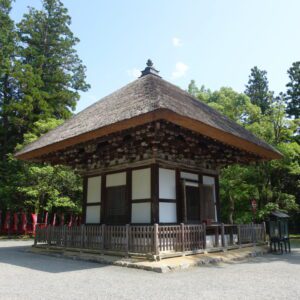
Kanshinji is a family temple of Kusunoki family such as Masashige Kusunoki. The head of Masashige Kusunoki, who died, was delivered to Kanshinji Temple and enshrined in Kubitsuka. I was impressed to be able to visit the land related to the military commander Masashige Kusunoki and Yukimura Sanada, which I liked when I was a child, on the same day.
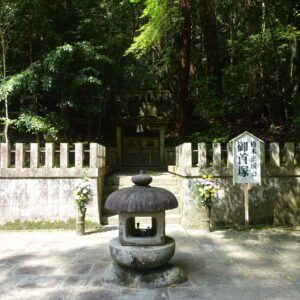
I went to Eboshigata Hachiman Shrine after Kanshinji Temple.
There was Eboshigata Castle, which is considered to be one of Kusunoki seven castles (Kawachi seven castles) at Mt. Eboshigatayama. It is said that Kojiro Kusunoki entered Eboshigata Castle and created a shrine to protect the castle, which is the beginning of Eboshigata Hachiman Shrine. The main shrine is designated as a national important cultural property.
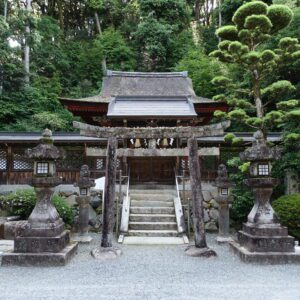
As the last sightseeing on June 8, I went to Nagano Shrine near Kawachinagano Station.
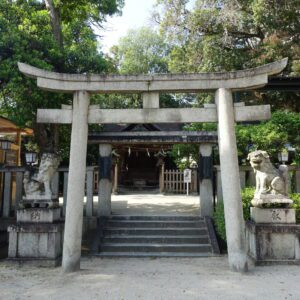
The main shrine of Nagano Shrine is said to have been built around 1543. The main shrine is designated as a national important cultural property. The god of worship is Susanoo-no-Mikoto (Gozu Tenno).
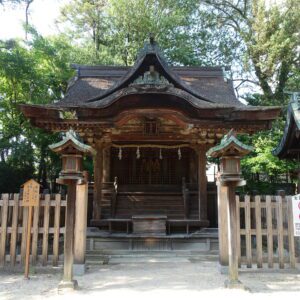
Meals
After sightseeing at Shitennoji Temple, I had okonomiyaki at “Abeton“, which is located a little more than 5 minutes away on foot. “Abeton” is located in an underground shopping mall called “Abechika”. It is located on the Shitennoji Temple side of “Abechika“, so it is a very good location for an okonomiyaki restaurant to go to after sightseeing at Shitennoji Temple. I entered the restaurant around 11:20 and was able to easily find a seat, but by 11:30 the restaurant was already full.
I ordered “Beef tendon Ponzu” (Yen 500) and “Abeton Mix” (Yen 1,700 ) at “Abeton”. The beef tendon ponzu is made from very tender beef tendon, making it easy to eat and very refreshing and tasty. It is a good menu item to have before okonomiyaki.
2-e1654998105450-300x300.jpg)
“Abeton Mix” is an okonomiyaki with lots of ingredients such as seafood and meat. It was a very delicious okonomiyaki with lots of ingredients and a satisfying taste. In particular, they used a lot of yam for their okonomiyaki dough, and their stickiness and softness created a nice texture. It was completely different from the hard dough offered by many okonomiyaki restaurants outside of Osaka. Also, since the sauce was applied with a brush on the mayonnaise, mustard, and ketchup that was applied on top of the okonomiyaki, the taste of the seasoning was exquisitely integrated to add good taste. This style was new to me and impressed.

Abeton has been in business since 1970. It has been selected as one of the 100 best restaurants in Japan by “Tabelog”. Abeton is the originator of Modern-yaki and Negi-yaki. Next time I visit Abeton, I would like to try their modern-yaki and negiyaki.
I had dinner at “Abaraya” in Namba. It is conveniently located a 5-minute walk from Namba Station. Namba Grand kagetsu is a 2-minute walk away. Although “Abaraya” is conveniently located, it may be a little hard to find because of its location in a narrow alley.
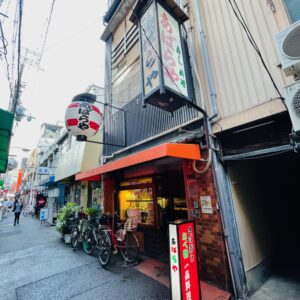
Abaraya is a long-established sushi restaurant established in 1955. The name “Abaraya” was chosen because the restaurant looked like “abaraya (shack)” when it was founded. The unpretentiousness typical of Osaka gives it a favorable impression.
The first thing that impressed me at Abaraya was the service set. The service set includes a draft beer, tsuki-dashi, assorted sashimi, and deep-fried tofu for only Yen 1,000. At such a low price, I was worried that the restaurant might go into the red. In the Kansai region, Otoshi (appetizers) are called tsuki-dashi and sashimi are called tsukuri.
The sashimi platter included red sea bream, greater amberjack, and octopus. Japan Fisheries Co-operative has selected “Naniwa no Madako” (season: June-October) as a summer “PRIDE FISH”. It is said that the name “Naniwa (Garden of fish)” originated from the name of a garden of fish, or a sea of abundance. I learned for the first time that “Naniwa (Garden of fish)” is the origin of the word “Naniwa” in the name of “PRIDE FISH”.
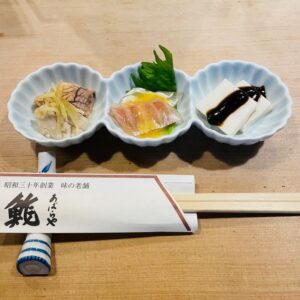

Next to the service set, I ordered “Grilled Sea Bass with Salt” and “Conger eel Ate”. The “Grilled Sea Bass with Salt” was Abaraya’s “Today’s Special”. Sea bass is in season from April to August, so I was able to enjoy it when it was fatty and delicious.

It was disappointing that the “Conger eel Ate” was not as meaty as it could have been. The gastronome Kitaoji Rosanjin wrote, “The best conger eel is found in the waters around Sakai. Next time, I would like to try thick-fleshed “Osaka conger eel”. The word “Ate” is mainly used in the Kansai region and means “side dish (relish)” or “snack.

My last meal at Abaraya was a half portion of their famous “mackerel sushi” (Yen 1,300 ). The mackerel sushi at “Abaraya” is made without vinegar, but only with salt. The mackerel sushi at Abaraya is made with only salt and no vinegar, which is said to concentrate the flavor of the mackerel. I like vinegar-pickled mackerel sushi, but I think I could enjoy the original taste of mackerel more because I could not smell or taste the vinegar in the mackerel sushi made with only salt. I was impressed by the great idea of using sansho (Japanese pepper) leaves to remove the smell of the mackerel and add the fresh aroma of sansho (Japanese pepper), as well as the beautiful coloring. The mackerel sushi looked and tasted fantastic.

I had a very satisfying dinner at Abaraya. I would recommend this restaurant to many people.
Important Points
The limousine bus is fast and convenient from Itami Airport to Namba Station. Since the limousine bus uses the highway, it only takes 25 minutes from Itami Airport to Namba Station. By the way, it takes 16 minutes by subway from Shin-Osaka station to Namba station, so there is no big difference from Itami airport to Namba station.
6. June 9 (Thursday) Day 2
I went to Toji Temple at 8:00 in the morning on June 9. Toji Temple is registered as a World Heritage site as a component of “Historic Monuments of Ancient Kyoto (Kyoto, Uji and Otsu Cities),” and its Kondo and five-story pagoda are designated as national treasure buildings. The five-story pagoda of Toji Temple is visible from the Shinkansen, making it the most viewed temple by visitors to Kyoto.
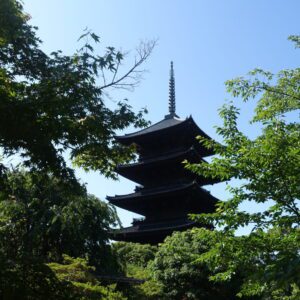
Toji Temple was founded in 796. It was built as an national temple for the protection of the Heian-kyo capital. Later, in 823, Emperor Saga bestowed Toji Temple to Kukai (Kobo Daishi), who made it the Konpon Dojo (fundamental training hall) of Shingon esoteric Buddhism. Toji Temple is the only remaining structure from the Heian-kyo period. Due to several fires, no buildings from the time of its foundation remain in Toji Temple. However, the orderly arrangement of the temple buildings in a straight line from south to north and the scale of each building remain as they were in the Heian period.
Kondo, a national treasure, was rebuilt in 1603 with contributions from Hideyori Toyotomi. The architectural style is a combination of the Wo-yo style and the Daibutsu-yo (Tenjuku-yo) style. The main statue, a Yakushi Nyorai, is 288 cm tall. It is very attractive with a calm expression. I felt as if I wanted to gaze at the Yakushi Nyorai statue forever. The statue of Yakushi Nyorai is a national important cultural property.

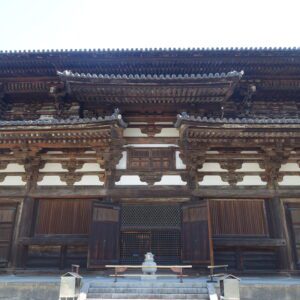
The Kodo (auditorium), a national important cultural property, was rebuilt in 1491. Inside the Kodo is a three-dimensional mandala consisting of a total of 21 Buddhist statues, 16 of which are national treasures and 5 are national important cultural properties. Inside the main hall, there are only three statues of Yakushi Nyorai and his two side chaplains, which I could appreciate very calmly, but the 21 statues inside the Kodo are too many for me to appreciate calmly. I prefer the inside of Kondo.

The five-story pagoda, a national treasure, was destroyed by fire four times due to lightning and suspected case of arson. It was rebuilt by Iemitsu Tokugawa in 1644. The five-story pagoda is 54.8 meters high, making it the tallest wooden pagoda in Japan. It is a very beautiful five-story pagoda with black as its base color. The bottom roof of the five-story pagoda is supported by an evil demon (Amanojaku). It is supported at the four corners.

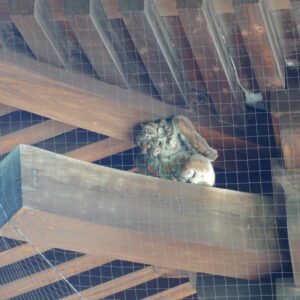
The East Gate is called “Akazu-no-mon” (meaning “the gate of non-opening”) due to the legend that Takauji Ashikaga, who was attacked by Yoshisada Nitta in 1336, escaped from the disaster by closing this gate. It is a national important cultural property.
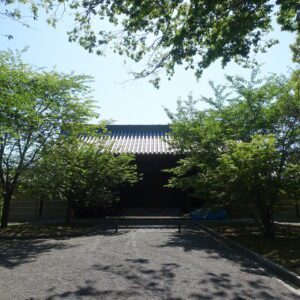
Keigamon, the entrance to Toji Temple, is also a national important cultural property.
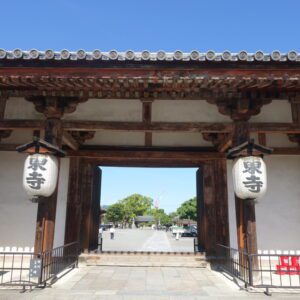
After a very satisfying morning tour of Toji Temple, I rented a bicycle and went to Fushimi Inari Taisha. Fushimi Inari Taisha is a very popular tourist destination for both domestic and international visitors due to the presence of the Senbon-torii (thousand torii gates). This was my first visit.
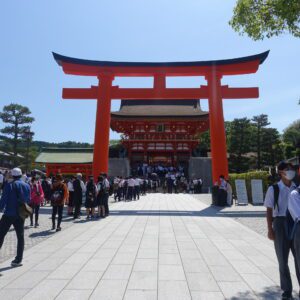
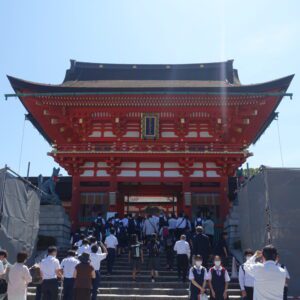
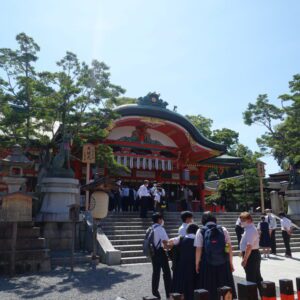
Fushimi Inari Taisha is the head shrine of the approximately 30,000 Inari shrines in Japan. Fushimi Inari Taisha was founded in the Wado period (708 – 715), and is mentioned in the Pillow Book and Konjaku Monogatari-shu. The shrine became a Shinto shrine on Buddhist temple grounds dedicated to the tutelary deity of the area during the construction of Toji Temple, and its beliefs expanded as it became associated with Shingon esoteric Buddhism. Even today, on the last day of the Inari Festival, Toji priests lay out offerings in front of the Keigamon and recite sutras, continuing the deep relationship between Fushimi Inari Taisha and Toji Temple.
The tower gate, main shrine, and outer shrine of Fushimi Inari Taisha are national important cultural properties.
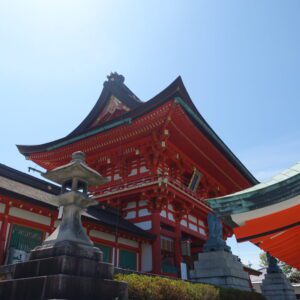

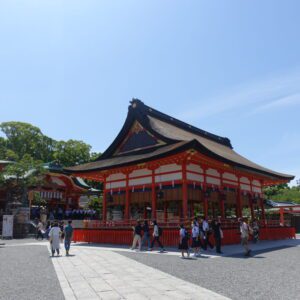
The area was overflowing with many tourists, but I miraculously encountered a timing when there were no tourists at all at the Senbon-Torii. Therefore, I was able to take pictures that did not show any people at all.
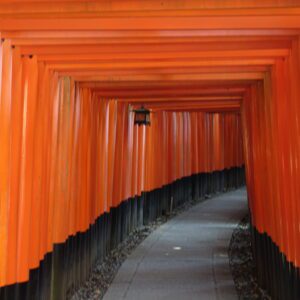
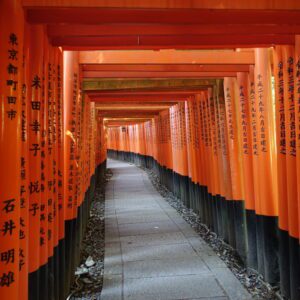
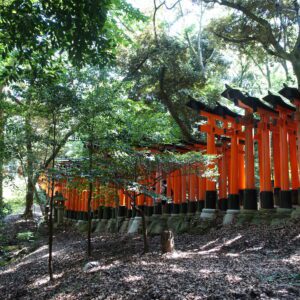
After Fushimi Inari Taisha, I went to Hotoji Temple.
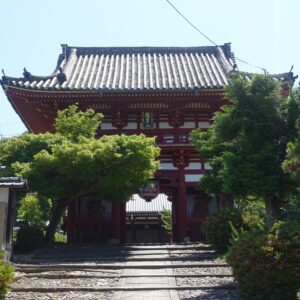
Hotoji Temple is said to be the predecessor of Gokuraku-ji Temple, a Shingon sect temple founded by Mototsune Fujiwara (the first Kanpaku, the chief adviser to the Emperor in Japanese history) in the Kasho era (848 – 851). It is also one of the settings of the Tale of Genji.
The main hall was rebuilt in 1608. It is the oldest main hall of a Nichiren Shu temple in Kyoto. It is designated as a national important cultural property.


The two-storied pagoda was built before 1439 in the Muromachi period (1336-1573). It is the oldest two-storied pagoda in Kyoto. At 11.4 meters in height, it is a small two-storied pagoda, but it is a very neat and well-balanced pagoda. The two-storied pagoda is also a national important cultural property.
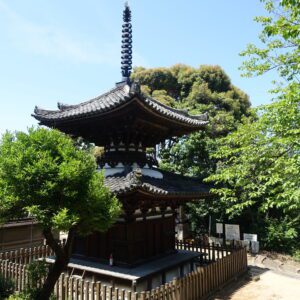
The main gate, built in the Muromachi Period (1336-1573), is also a national important cultural property.
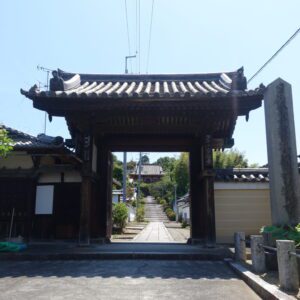
After Hotoji Temple, I went to Tofukuji Temple.
Tofukuji Temple was founded in 1236. The name of the temple was taken from the characters for “To” and “Fuku” in the two major temples in Nara Prefecture, Todaiji Temple and Kofukuji Temple, and the temple was named Tofukuji Temple. The regent Michiie Kujo (father of the fourth shogun of the Kamakura Shogunate, Yoritsune Fujiwara) built the largest temple complex in Kyoto and constructed Tofukuji Temple. Tofukuji Temple was selected as the fourth temple rank in the “Kyoto Gozan (Five Temples of Kyoto)” (temple ranks of the Rinzai sect) established by Yoshimitsu Ashikaga, the third shogun of the Muromachi Shogunate. The “Kyoto Gozan” temples are Nanzenji Temple (ranked separately), Tenryuji Temple (ranked first), Shokokuji Temple (ranked second), Kenninji Temple (ranked third), and Manjuji Temple (ranked fifth).
The Sanmon Gate was rebuilt in 1425 by Yoshimochi Ashikaga, the fourth shogun of the Muromachi Shogunate, and is a national treasure. It is the oldest and largest existing gate of a Zen temple in Japan. It is approximately 22 meters high.


The main hall was rebuilt in 1934. It is one of the largest wooden buildings of the Showa period. The Hojo, surrounded by the Honbo garden “Hasso no Niwa,” was rebuilt in 1890.

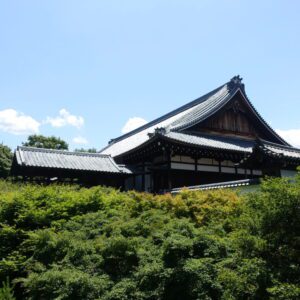
Tosu is the remains of the largest and oldest Zen-style latrine in Japan. It is designated as a national important cultural property. The scripture house was rebuilt in 1794.
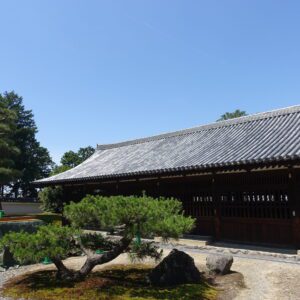
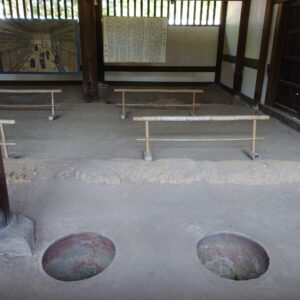
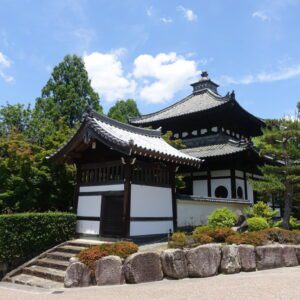
The Honbo Garden “Hasso no Niwa” is a national scenic beauty. The garden was created by landscape architect Mirei Shigemori in 1939. The dry landscape garden is so beautiful that one could gaze at it forever.



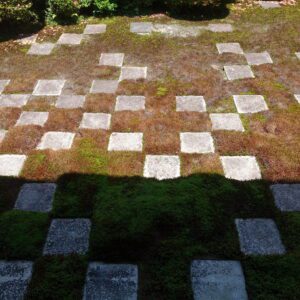
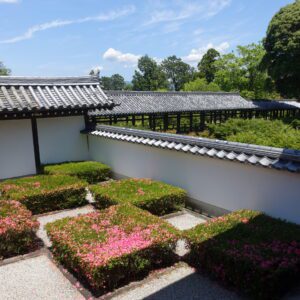
Tsutenkyo Bridge connects the main hall and the Kaisando. During the fall foliage season, it is one of the best views in Kyoto.
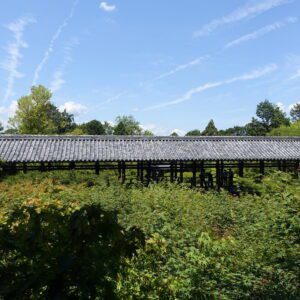
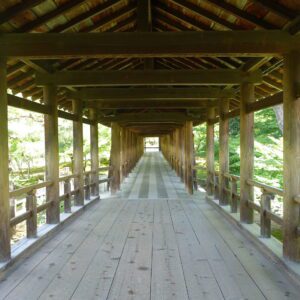
The Kaisando enshrines a statue of the founder of the temple, Enni Ben-En (Shoichi Kokushi). It is designated as a national important cultural property. The garden in front of the Kaisando was very beautiful.
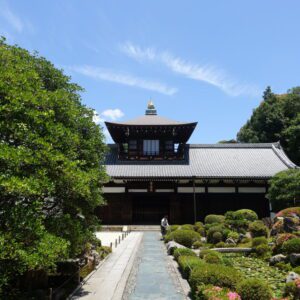

Aizendo, located near Tsutenkyo Bridge and Kaisando, was moved in 1937 from Manjyu-ji Temple, one of the “Kyoto Gozan” temples. It is an octagonal circular hall with a vermillion lacquering wall and shingled roof. The red Aizendo stands out from the muted colors of the Zen Buddhism buildings at Tofukuji Temple. It is a national important cultural property.
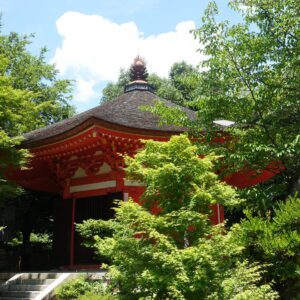
The zendo was rebuilt in 1347. It is the largest and oldest existing zendo in Japan, and it is hard to believe that it was built nearly 700 years ago, with such a beautiful appearance. It is a national important cultural property.
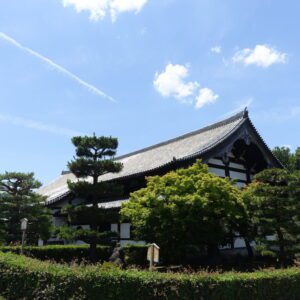
Engetsukyo Bridge is a wooden bridge corridor that was rebuilt in 1603. Unlike the Tsutenkyo Bridge, it is open to traffic free of charge. It is designated as a national important cultural property and is one of the 100 most famous bridges in Japan.
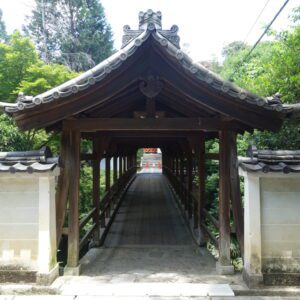
Tofukuji Temple is one of the largest temple complexes in Kyoto, and it took us about two hours to visit them all. It was a very worthwhile Zen temple.
Saisho Kongoin Temple is a special historic temple of Tofukuji Temple that was reestablished to manage the tombs of the Kujo family. Hakkakudo is the mausoleum of Kujo Kanemi. Kanezane Kujo held the offices of regent, Kanpaku, and Grand Minister. He was the grandfather of Michiie Kujo, who built Tofukuji Temple, and the founder of the Kujo family.

Funda-in is a Tacchu of Tofukuji Temple. A Tacchu is a small Zen temple built to commemorate the death of a high priest. Funda-in was founded by Tsunemichi Ichijo in the Genko era (1321-1324) for his father Uchitsune Ichijo, with Jozan Sozen as the founder of the temple. It is the family temple of the Ichijo family of the Sekkan family (Konoe, Ichijo, Kujo, Takatsukasa, and Nijo families).
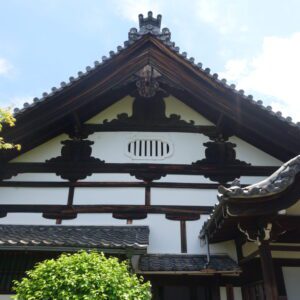
The south and east gardens of Funda-in are dry landscape gardens said to have been created by Sesshu, a famous ink painting artist. For this reason, Funda-in is also called Sesshuji Temple.
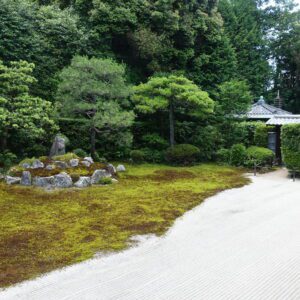
I went to Unryu-in next to Fundain. It took about 10 minutes by bicycle. Unryu-in is a branch temple of Sennyuji Temple, which will be described later. It was founded in 1372 by the Emperor Go-Kogon of the Northern Dynasty in the Nanbokucho Period (1368-1368), with Chikugan Shoko as its founder.
Ryukaden (the main hall) has been a place for sutra copying since Emperor Go-enyu believed in the merits of sutra copying. When I visited, there was a person performing sutra copying. Ryukaden was rebuilt in the Kanei era (1624-1644). It is designated as a national important cultural property. The lantern in the photo with Ryukaden was donated by Yoshinobu Tokugawa, the last shogun of the Edo Shogunate.
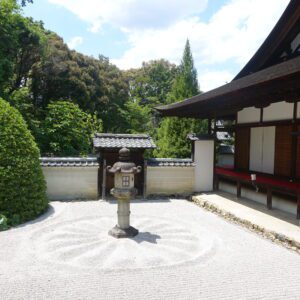
Reimei-den, rebuilt in 1868, is a hall of honor for the royal family.

The Lotus Room has four colored paper-sized windows that offer a beautiful view of the garden, called “Shikishi-no-keshiki.
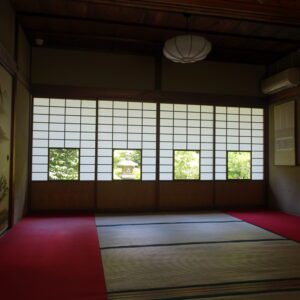
The window in the Shoin Gonoma is called the “Window of Enlightenment” and offers different views depending on the season.

In the Dairin Room, there is a calligraphy of “Ryuen” by Kuranosuke Oishi, who was the first retainer (leader) of the Ako Roshi. It is said that Kuranosuke Oishi, who lived quietly in Yamashina, held a secret rites with the former Ako Ronin at Raigo-in Temple, the Tacchu of Sennyuji Temple.

In addition to the “Shikishi-no-keshiki” and “Window of Enlightenment,” Unryu-in is a fun temple to visit, with many other fascinating features. The “Running Daikokuten (Mahakala)” statue, of which photography is prohibited, is a must-see. It will change your impression of Daikokuten (Mahakala).
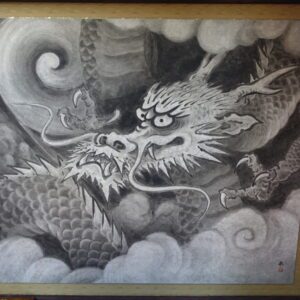
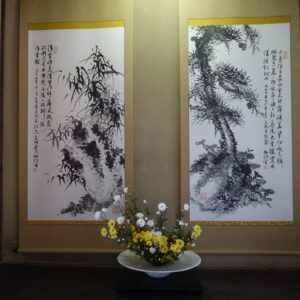
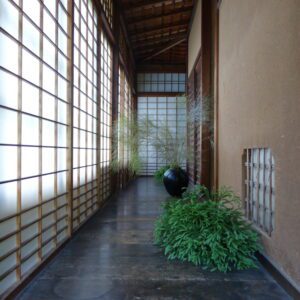

Sennyuji Temple is located near Unryu-in. It is the head temple of the Sennyuji School of Shingon Buddhism. The name Sennyuji comes from the fact that fresh water gushes out from a corner of the temple grounds. The temple is also called “Mitera,” meaning “temple of the emperor,” because of its close connection with the imperial family, as it has hosted many funerals of emperors. The domain name of Sennyuji Temple is also mitera.org. It is said to have been founded in 856, but there are various theories.
The main gate of Sennyuji Temple, the Daimon, was relocated from the south gate of the Kyoto Imperial Palace during the Kanei period (1624-1645). It is designated as a national important cultural property. Most Shinto shrines and Buddhist temples have a slope or stairs leading up from the main gate to the main hall or Buddha hall, but Sennyuji Temple is unusual in that it is located down a slope.
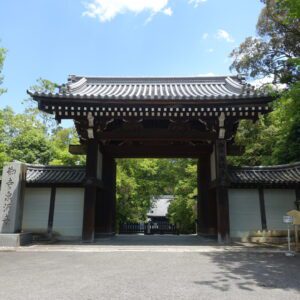
The Buddhist temple was rebuilt in 1668 with the assistance of the fourth shogun of the Edo Shogunate, Ietsuna Tokugawa. It is designated as a national important cultural property.
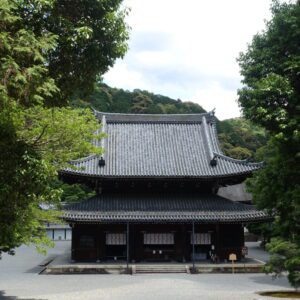
The Shariden, which stands behind the Buddhist temple, is a relocated and remodeled building from the Kyoto Imperial Palace during the Keicho era (1596-1615).
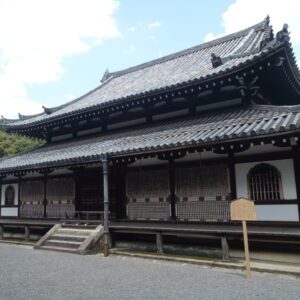
Reimmei-den enshrines the tablets of successive Emperors and Empresses from Emperor Tenji and Emperor Konin to Emperor Showa. The present Reimei-den was rebuilt in 1884 by order of Emperor Meiji.

Sennyusui Yakata was rebuilt in 1668. It is designated as a Tangible Cultural Property of Kyoto Prefecture. It is a yakata that covers the fountain from which Sennyuji Temple derives its name.
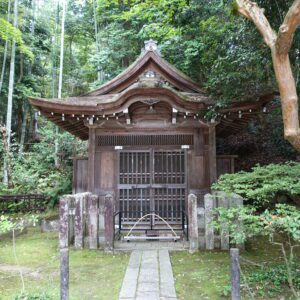
Meals
For my first lunch in Kyoto, I had hamo (conger pike) somen (Yen 1,380 ) at “Soba Restaurant Aoi” located in the Kintetsu Mall Miyakomimichi in Kyoto Station. I chose the somen despite the fact that it is a soba noodle restaurant because it has Hamo no Yubiki (parboiled conger pike) on top of the somen.
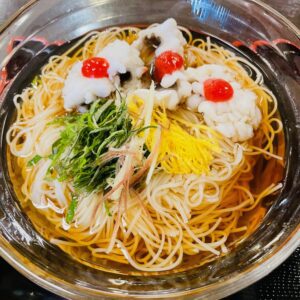
Hamo (conger pike) cuisine is famous for Kyoto in summer. I definitely Hamo no Yubiki (parboiled conger pike) as my favorite hamo dish. I think the contrast between the white parboiled hamo and the red plum sauce is a great contrast and looks very nice. There are not many white and red dishes other than parboiled hamo, which is why it makes parboiled hamo stand out against other dishes. The hamo no somen was also a very beautifully colored dish and tasted very good. I think it is the perfect cool looking dish for the hot Kyoto summer.
I have long wondered why hamo (conger pike), which is caught mainly in the Seto Inland Sea, is so famous as a hamo dish in Kyoto. So I looked into the reasons why hamo dishes are a Kyoto specialty.
The Gion Festival, held in July, is called the Hamo Festival. Hamo (conger pike) are in season from June to July, when they are spawning. The hamo season coincides with the Gion Festival, and the hamo were used to entertain visitors with hamo dishes, hence the name “Hamo Festival”.
In addition, Kyoto, which was the capital of Japan, had fish peddlers who brought fish from Osaka and Hyogo prefectures. Because of its strong vitality, hamo was one of the few fish that could be brought to Kyoto even in the summer, when the fish tended to be damaged (rot easily). Also, because hamo belongs to the order of eels, it is rich in vitamins B12 and D, which, like eels, help prevent summer heat fatigue. For these reasons, Kyoto people began the custom of eating hamo in summer.
The reason why people outside of Kyoto do not eat hamo is because it is difficult to cut the hamo bones. Hamo need to be “bone-cutting” in order to be eaten because they have many small, hard bones. Since this “bone-cutting” requires a great deal of skill, there are few chefs outside of Kyoto, where hamo cuisine is popular, who can perform this task.
The catch of eel is decreasing every year and the price of eel is soaring. If the price of eel continues to rise, more and more cooks will learn to “bone-cutting” and people outside of Kyoto may end up eating hamo instead of eel.
We had dinner at “Seppourai” in Kyoto Station Building. I interviewed for a part-time job from 3:00 p.m. to 5:00 p.m., and then we had dinner together at “Seppourai”. The word “Seppourai” means “do not reject anyone who comes to the restaurant”.
“Seppourai” is a restaurant serving Kyo-yasai (Kyoto vegetables). Despite its very convenient location, we were very satisfied with the affordable prices and delicious food.
I ordered “Kamo eggplant and beef grilled in soy sauce,” “grilled Manganji pepper,” “Yuba roll with Kyoto vegetables and shrimp,” “Kyoto yuba spring roll,” “Kyoto nama-fu dengaku,” “Hamo no otoshi,” “Lotus root and shrimp kakiage,” “Cold shabu-shabu salad with Japanese black beef” and “Suzuki (sea bass) carpaccio”.
It can be said that Kamo eggplant is the most famous Kyoto vegetable. This time, I ate it not as dengaku but as “Kamo eggplant and beef grilled in soy sauce”. It was my first experience to eat Kamo eggplant with beef, but it was a very delicious dish.
 賀茂茄子-e1655266529246-300x300.jpg)
Manganji peppers are said to have been created by crossing Fushimi peppers with California peppers in the Manganji district of Maizuru City, Kyoto Prefecture, between the late Taisho and early Showa periods. It is characterized by its thick flesh and volume, and despite being a pepper, it is not pungent. The grilled Manganji pepper are also very tasty.
 万願寺-e1655266807512-300x300.jpg)
“Yuba” and “nama-fu” are often used in vegetarian cooking. “Yuba” is the thin skin that forms on the surface of heated soy milk. “Nama-fu” is wheat gluten mixed with rice flour and steamed in large blocks. They can be considered local dishes in Kyoto, where there are many Buddhist temples. “Yuba” is said to have been brought back from Tang China by Saicho during the Heian period (794-1192), about 1,200 years ago. On the other hand, the production of fu is said to have been introduced by Zen monks from Ming Dynasty China in the early Muromachi Period (1336-1573). Both of these ingredients were related to Buddhism from the beginning.
 水菜-e1655266881471-300x300.jpg)
 湯葉天ぷら-e1655266945152-300x300.jpg)
 麩-e1655266986361-300x300.jpg)
“Hamo no otoshi” is a dish made by dipping a hamo (conger pike) in boiling water. I had it for lunch with somen noodles, and I ordered it for dinner as well.
 鱧湯引き-e1655267237505-300x300.jpg)
The dishes I ordered this time, “Lotus root and shrimp kakiage,” “Cold shabu-shabu salad with Japanese black beef” and “Suzuki (sea bass) carpaccio” are not Kyoto dishes. I ordered them because they looked delicious, and all three dishes were very tasty.
 天ぷら-e1655264683931-300x300.jpg)
 サラダ-e1655264717489-300x300.jpg)
 鱸のカルパッチョ-e1655264750734-300x300.jpg)
Important Points
Fushimi Inari-taisha Shrine was very crowded even after 9:00 a.m. when I visited. To avoid the crowds, it is better to visit Fushimi Inari-taisha early in the morning, such as around 7:00 a.m. Fushimi Inari Taisha Shrine is open 24 hours a day, but Omamori (the good luck charm), Goshuin (seal stamp given to worshippers) , etc. are available from 8:00 to 17:30.
Toji Temple opens at 5:00 and closes at 17:00. However, the Kondo and Kodo (auditorium) are open from 8:00 to 17:00 (reception closes at 16:30), and the Treasure House and Kanchi-in are open from 9:00 to 17:00 (reception closes at 16:30).
Tofukuji Temple has irregular visiting hours: 9:00-16:00 from April to the end of October (registration closes at 16:00), 9:00-16:00 from November to the first Sunday in December (registration closes at 16:00), and 9:00-15:30 from the first Monday in December to the end of March (registration closes at 15:30).
The three famous tourist attractions I visited on June 9 should be visited efficiently according to their respective viewing times. A good order would be Fushimi Inari-taisha Shrine, Tofukuji Temple, and Toji Temple.
7. June 10 (Friday) Day 3
I went to Miyama, Nantan City, Kyoto Prefecture, in the morning on June 10.
I got off at the Miyama Clinic bus stop and rented a bicycle at the Kyoto Tamba Kogen Quasi-National Park Visitor Center to go to Miyama’s Thatched Village (Kayabuki-no-Sato).
It took about 20 minutes to get to “Miyama’s Thatched Village (Kayabuki-no-Sato)” by bicycle. It was very pleasant to ride the bike along the country roads while viewing the beautiful mountains and countryside.
“Miyama’s Thatched Village (Kayabuki-no-Sato)” is a national Important Preservation District for Groups of Traditional Buildings. It has also been certified by UNWTO (United Nations World Tourism Organization) as a “Best Tourism Village” for 2021.
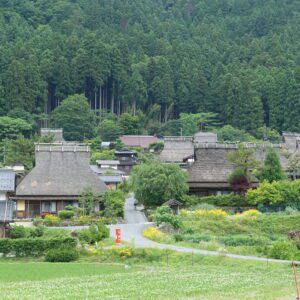
In “Miyama’s Thatched Village (Kayabuki-no-Sato)”, there are still many thatched-roof houses; 39 of the 50 houses have thatched roofs. However, since Shirakawa-go, a World Heritage site, has more than 100 thatched-roof houses (gassho-zukuri), it is hard to deny that the “Kayabuki-no-Sato” is inferior in terms of scale. On the other hand, because it is not as big a tourist attraction as Shirakawa-go, “Miyama’s Thatched Village (Kayabuki-no-Sato)” is very quiet and you can enjoy a leisurely stroll.

I was told by a resident that it costs nearly Yen 10 million per house to replace the thatch, which is done at a pace of about once every 15 years. I also learned that because the area is a national Important Preservation District for Groups of Traditional Buildings, the residents bear a very heavy financial burden, although they receive an 80% subsidy from the government.
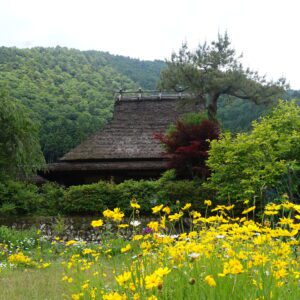
Miyama folklore museum is located in the central part of “Miyama’s Thatched Village (Kayabuki-no-Sato)”. Visitors can see old kimonos, playthings, threshing machines, etc. from the Edo, Meiji, and Taisho periods. You can also see the attic room, so you can learn all about the inside of a thatched house at the Miyama folklore museum.
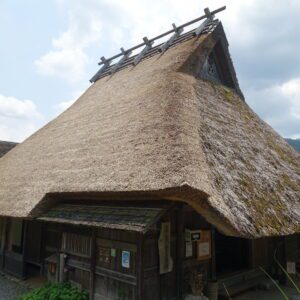
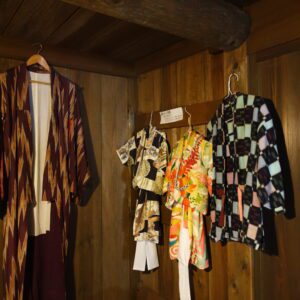
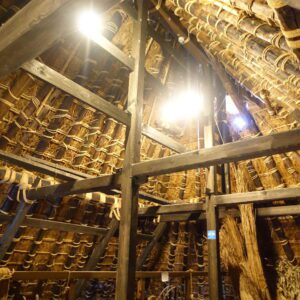
Chii Hachiman Shrine, located near “Miyama’s Thatched Village (Kayabuki-no-Sato)”, was built in 1071. The present main shrine was rebuilt in 1767. The carvings on the main shrine have earned it a reputation as a representative shrine of the Tamba region. Miyama is also located on the Saba Kaido (Wakasa Kaido) road connecting Obama in Fukui Prefecture and Kyoto. The shrine was crowded with peddlers who transported fish and other seafood. It is designated as a cultural property by Kyoto Prefecture.
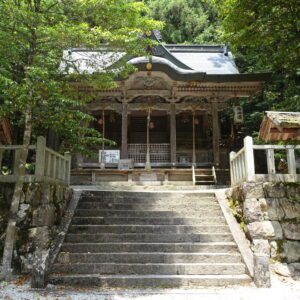
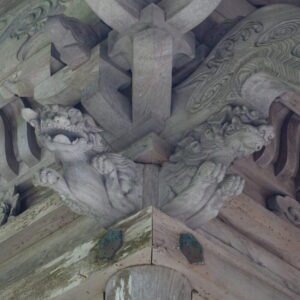
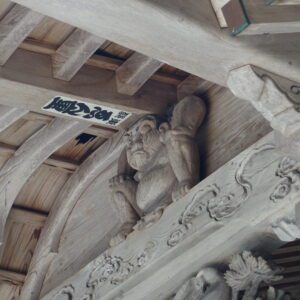
The Noh stage of Chii Hachiman Shrine is aligned between the main hall and the torii gate. Therefore, from the main hall, the mountains in front could be seen beautifully from the Noh stage, which was a wonderful view.
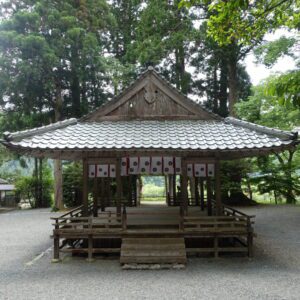
The Kobayashi Family Residence is a national important cultural property and was built in 1816. The Kobayashi Family was an old family that served as a deputy officer of the Sonobe Domain.

I went from Hiyoshi station to Nagoya station via Kyoto station. The reason I went to Nagoya was to reunite with a friend from my college days after a long time.
After arriving in Nagoya, I had some time before meeting my friend, so I toured Nagoya City Hall and other places.
The main Nagoya City Hall was completed in 1933. It is the second oldest city hall among ordinance-designated cities after Kyoto City Hall, which was completed in 1927. It is a modern building with an unusual Japanese-style tiled roof. It was designed by Kingo Hirabayashi, who also designed the Osaka Prefectural Office Building. It is designated as a national important cultural property.
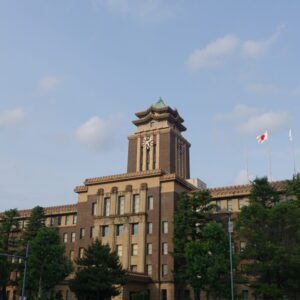
The Aichi Prefectural Government Building was completed in 1938. It is a rather unusual shaped building with a roof in the style of the great keep of Nagoya Castle. It is located next to the main Nagoya City Hall and is designated as a national important cultural property.
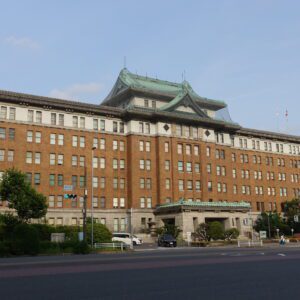
Nagoya Castle is a 5-minute walk from Nagoya City Hall and Aichi Prefectural Government Building. This time I could not see Nagoya Castle, which can be visited only until 17:00. I am posting a photo of a rainbow over Nagoya Castle that I saw during a previous visit to Nagoya, because it was so beautiful. If you compare it with the Aichi Prefectural Office Building, you will see that the roofs are almost the same color shade. Nagoya Castle’s three turrets and other structures are also designated as national important cultural property.
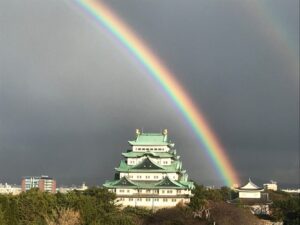
Before heading out to dinner with friends, I went to see the “Nana-chan Doll”. This giant mannequin stands 610 cm tall and weighs 600 kg in front of the Young Pavilion of the Meitetsu Department Store.
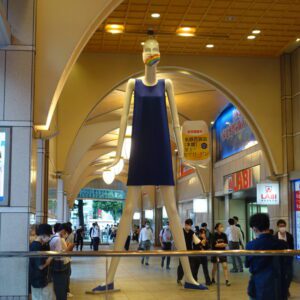
Meals
I had a late breakfast before my stroll at “Miyama’s Thatched Village (Kayabuki no sato)”. I ordered “mori soba” (Yen 840), “rice with raw egg” (Yen 320), “dish simmered in regional chicken liver” (Yen 430), and “dish simmered venison with ginger” (Yen 430) at “Restaurant Kitamura“.
“Mori soba” is most popular buckwheat noodle at “Restaurant Kitamura”. It is made from buckwheat flour harvested in Miyama and ground on a millstone. The soba noodles are handmade in the restaurant every day. Despite being handmade soba, the noodles were very thin and made me feel that they were well worked. The amount of Soba was a little small, but it was a very tasty “mori soba”.

The “rice with raw egg” was made with freshly caught local eggs, and the rich yolk of the egg was delicious and irresistible.


The chicken and venison used in the “dish simmered in regional chicken liver” and “dish simmered venison with ginger” were also caught in Miyama. The meat is locally produced, full of flavor, and very tasty. It was a wonderful experience to eat breakfast using locally grown ingredients while breathing fresh air on the terrace overlooking the Miyama River (Yura River) that runs next to “Restaurant Kitamura”. It was a very enriching experience.

After enjoying a walk around “Miyama’s Thatched Village (Kayabuki no sato)”, I went to “Cafe Milan” to eat pudding. Cafe Milan is both an egg market and a café at Nakano Chicken Farm in “Miyama’s Thatched Village (Kayabuki no sato)”. It is located near the Miyama Folk Museum. Nakano Chicken Farm is located near “Restaurant Kitamura.

The pudding is handmade with rich eggs and raw farm milk as ingredients. The pudding looks like an egg from the top and is visually delicious as well. The pudding was so delicious that I ate it on the terrace while enjoying the view of “Miyama’s Thatched Village (Kayabuki no sato)”.

After a full day of exploring “Miyama’s Thatched Village (Kayabuki no sato)”, I cycled back to the Kyoto Tamba Kogen Quasi-National Park Visitor Center, about 20 minutes away, and had sweetfish cuisine at “Takeyoshi”.
The Miyama River (Yura River) is famous for its delicious sweetfish. The Miyama River grows high-quality diatoms that the sweetfish feeds on, which makes the sweetfish tasty. In 2022, the ban on tomozuri fishing (angling by decoy) for sweetfish was lifted on May 28. The ban on net fishing for sweetfish is scheduled to be lifted on August 21.
“Takeyoshi” offers sweetfish dishes without reservations. I had “Takeyoshi” for “grilled sweetfish with salt” (Yen 1,200), “whole sweetfish sushi” (Yen 1,200) and “Uruka” (Yen 200).
“Grilled sweetfish with salt” is the most famous way to eat sweetfish. When I visited Miyama on June 10, it was just after the opening of the sweetfish fishing season (May 28), so the sweetfish was still small. Even so, it was a very tasty “grilled sweetfish with salt” with no smell at all.

As far as I can remember, I think this is the first time I ate “whole sweetfish sushi”. We can eat “whole sweetfish sushi” with the head of the sweetfish. Therefore, small sweetfish caught just after the opening of the sweetfish fishing season are more delicious and the head is more tender. The sweetfish sushi I had was also very tasty. I was glad to be able to try a new way of eating sweetfish other than “grilled sweetfish with salt”.


“Uruka” is salted sweetfish guts (internal organs). Takeyoshi’s Uruka was served on a bed of tofu. Sweetfish is one of the few fish that can eat its guts. This is because sweetfish feeds on algae, which is harmless to humans. Sweetfish guts are rich in vitamin A. Although it has a slightly bitter taste, “Uruka” is worth trying as a summer delicacy that can only be eaten during the sweetfish fishing season.

“Takeyoshi” has the unassuming appearance of an ordinary diner, but the taste and customer service were excellent. Located near the Kyoto Tamba Kogen Quasi-National Park Visitor Center, this is a restaurant that many people should visit.
I moved to Nagoya and ate Kishimen at “Sumiyoshi” on the station platform. I love the Kishimen at “Sumiyoshi” on the Nagoya station platform, and I always have it whenever I come to Nagoya. I think Yen 500 for a bowl of kishimen with shrimp tempura and onsen-tamago (soft boiled egg) is a very good price. I was very satisfied with the taste of “Sumiyoshi” Kishimen, which is always the same.

After a short walk around Nagoya, I had dinner at “Kabuto” with a friend from college. Kabuto is a very popular izakaya with counter seating only, located under the Shinkansen viaduct near Nagoya Station. It was very crowded on June 10 when we visited. We had a very satisfying dinner of sculpin tempura, deep-fried tofu, deep-fried fish ball, and assorted sashimi (not pictured).



Since there were many people waiting in line outside Kabuto, we quickly left the restaurant and went to Izakaya Tsuruhachi, which is located near Kabuto, to have another drink. Izakaya Tsuruhachi is an izakaya that serves many local dishes of Nagoya, and we ordered “fried chicken wings” and “Dote-ni”.
Fried chicken wings are often eaten in the Nagoya area. The origin of this dish is said to be “Furaibo”, which was developed by Kengo Otsubo, the founder of Furaibo, who came to Nagoya from Kokura in Kitakyushu in 1963. Kengo Otsubo had made half a young chicken into his signature dish, “Tarzan-yaki,” but one day his supplier had no orders for young chicken. As a desperate measure, he fried the chicken wings and dipped them in “Tarzan-yaki” sauce, which became a big hit. For me, “Furaibou” sauce is a little too sweet, so “Furaibou” “fried chicken wings” is not my favorite. However, I think it is a great contribution to the spread of “fried chicken wings” in Nagoya.

“Dote-ni” is another Nagoya specialty. It is a dish of beef tendon and motsu (internal organs) slowly simmered in hatcho miso (soybean paste). For me, “Dote-ni” also seems a bit sweet, and I prefer regular stewed motsu, but when in Nagoya, I can’t help but order it.

Important Points
Nantan City buses require passengers to say where they are going before boarding. The fare is paid in advance. The boarding procedure may be difficult for foreign visitors who do not understand Japanese. Note that there is a one-day pass (Yen 1,200) that can be purchased inside the bus, which is a good deal for those who travel by public transportation without renting a bicycle.
Note that there are only five restaurants in Miyama where we can eat sweetfish without a reservation.
Note: The departure / arrival times, fares of transportation, admission fees, meal fees, etc. listed in the text are as of the time of writing the BLOG. Please check for yourself when you go on a trip as it may change in the future.